Effects of Auditory Stimuli on Empathic Emotion
Main Article Content
Abstract
Individuals are exposed to a variety of stimuli that elicit empathy. However, it is unclear whether the sensory mode (i.e., auditory or visual) through which a stimulus is perceived influences empathic responses. The present study experimentally examined the differences between audiovisual communication channels in their ability to elicit empathic reactions from undergraduate students. Participants completed the Balanced Emotional Empathy Scale (BEES: Mehrabian, 2000) in order to determine one’s emotional empathy trait prior to visually, aurally, or audiovisually viewing a short video clip of an infant child in a state of distress. Subsequently, the participants rated their emotional reactions to the video clip based on subjective level of distress, how upset participants felt, and participants’ desire to help the infant. There were no statistically significant effects of the presentation style of the video on participants’ upset reactions or participants’ desire to help. However, the effect of the stimuli presentation on participants’ level of distress was statistically significant, particularly among participants with “very below average” or “below average” empathy traits. The findings of the present study suggest that empathic responses are greatest when an individual can see and hear another individual in distress, as he or she cannot misinterpret the incoming information.
Article Details
Section
Articles

This work is licensed under a Creative Commons Attribution-NonCommercial 4.0 International License.
How to Cite
Musson-Moyer, F. (2012). Effects of Auditory Stimuli on Empathic Emotion. Graduate Student Journal of Psychology, 14, 13–21. https://doi.org/10.52214/gsjp.v14i.10875

